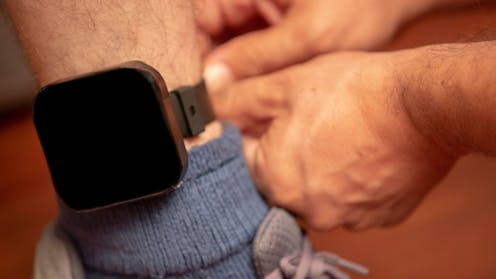Technology could open up new ways to track prisoners
Ankle bracelet monitoring technology could be taken a step further. Stock City/Shutterstock
Technology firms have apparently suggested placing tracking devices or a microchip under the skin of convicted criminals to monitor them in prison or when they come out, according to a recent report in the Guardian. Though the idea raises questions about human rights, the technology is certainly developing that could make such an initiative possible.
Electronic ankle bracelets are already widely used forms of this technology. They normally use a radio frequency connected to a base station, similar to your home WiFi, to ensure the device is within a specific range in or around the house. Others use GPS to monitor the location of the person. Such devices require regular charging, however.
Anyone can use commercial technology such as AirTags from Apple or the Samsung SmartTag that allow people or items to be tracked. The monitoring technology is integrated with mobile phone applications. This includes the use of other people’s phones in an encrypted network of communications.
In the UK, there are different types of technologies available that utilise GPS and other wireless systems to monitor individuals who are subject to movement restrictions because of a court order.
The technology was first introduced in the UK in 1999 and it is normally used as an alternative to custody or imprisonment. According to a UK government website, there are three types of tagging: curfew tags, location tags and alcohol tags. A curfew tag checks the location of the tagged person from a base unit (such as their home) within a specific time period.
If the base unit cannot communicate with the tagged person, it will send an alert to the related monitoring centre. Location tags have more flexibility as they monitor the location and provide information about areas that the person should not access or should visit such as rehabilitation appointments.
The third most common type are alcohol tags where the alcohol level is measured from the sweat of a person. The aim is to reduce violence or crimes related to intoxication of alcohol. In 2022, the UK government reported that approximately 97% of offenders’ with these tags stayed off alcohol.
In general, greater use of electronic tagging could lead to more prisoners being released early and so help reduce the pressure on prison facilities. This could have other social benefits such as avoiding any disruption of employment or family commitments.
However, limitations such as problems with the device signal or false alarms for breaching court orders have been observed in several studies. A 2019, study by the Scottish Government highlighted some of the strengths and weaknesses of these technologies. However, with the continuous development of monitoring technologies, such limitations are expected to be addressed with more effective applications in the future.
Chips could be implanted under the skin.
Alexa Mat/Shutterstock
Technology that involves implanting tags under the skin has been explored in in the past for applications such as proof of identity, contactless payment systems and the opening of secure doors.
One type of implant uses a radio frequency identification (RFID) tag and is about the size of a grain of rice. In theory, similar technology could be used with a base unit or distributed monitoring network to develop a tracking system to locate a person.
RFID tagging is used routinely in supermarkets to prevent theft. The tags are often attached to expensive items to prevent them from being taken from the store without payment.
However, human rights campaigners have called the proposals from the tech companies for microchip trackers and other devices “dystopian”. Forcing people to undergo invasive surgery to enable technology firms to gather what could become highly sensitive and personal data about them takes punishment a step beyond the temporary restriction of people’s freedom of movement.
Electronic monitoring technologies, with AI support, are advancing at rapid pace. In the future and globally, the technology is expected to play a vital role in enhancing public safety, supporting rehabilitation and minimising the cost to public funding. But questions also have to be answered about what role we want this kind of technology to play in our society.
Amin Al-Habaibeh receives funding from Innovate UK, The British Council, The Royal academy of Engineering, EPSRC, AHRC, and the European Commission.




